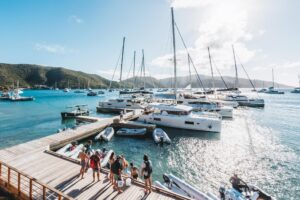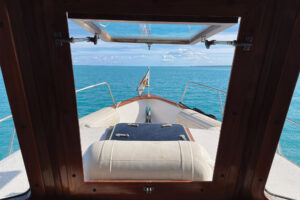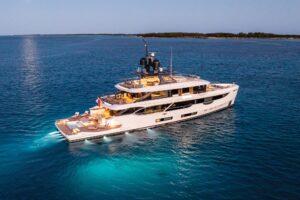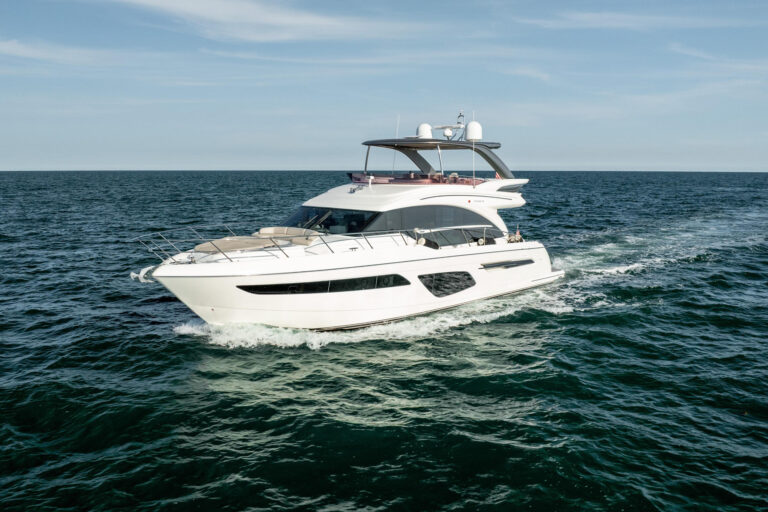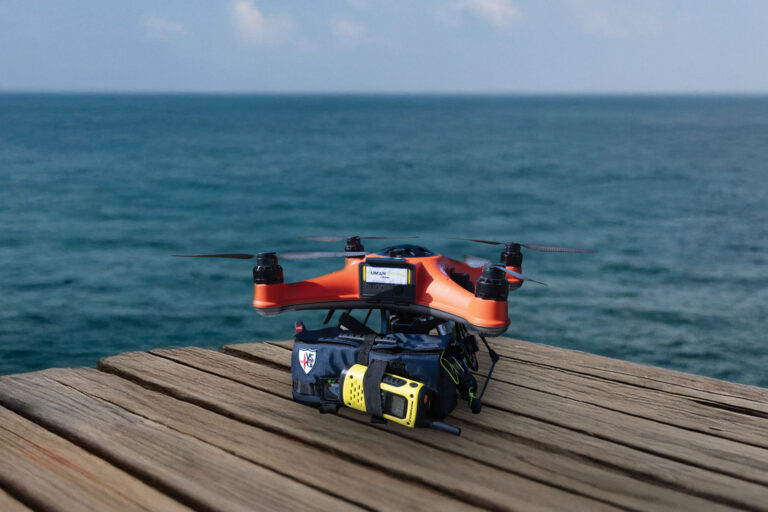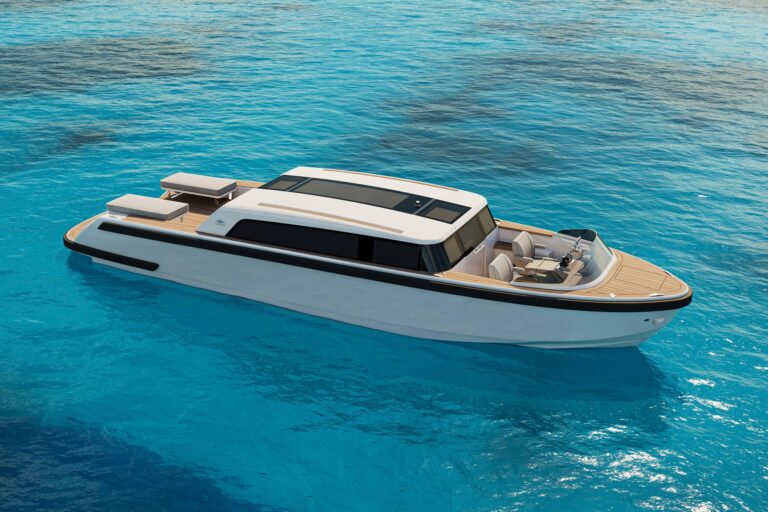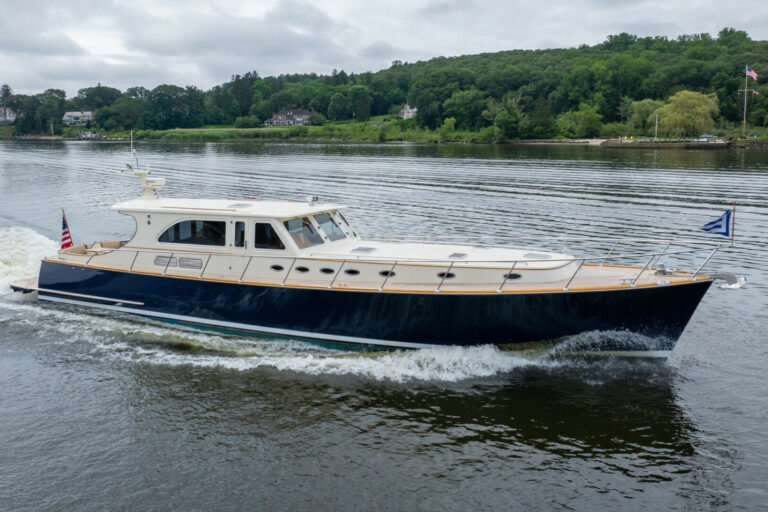
The rising sun illuminates the easter skies off St. Augustine, Florida, casting a crisp light on still waters. As usual when he’s aboard, Louis Chênevert, the former CEO of a Fortune 50 company, is at the helm of Debbie Lou, the heavily customized Horizon P105 he commissioned last spring. Chênevert taps one of five 19-inch touch-screen monitors residing on his helm console — he has memorized every onboard schematic, plus myriad other technical details — and expertly coaxes Debbie Lou out of the harbor, demonstrating the finesse of a mariner long accustomed to maneuvering his yachts.
While Debbie Lou is a far cry from the Bayliner 26 that launched this yachtsman’s journey as a boat owner, Chênevert, a manufacturing expert, constantly strives for the sort of operational perfection that was the hallmark of his career.
“I’m very comfortable operating the boat,” says Chênevert, a thin-but-earned glimmer of pride audible. “The crew says that I dock her better than anyone else.” After a few more touch-screen taps and a final check of the OctoPlex digital-switching system, Chênevert hands the helm to his captain of 11 years. He joins his wife, Debbie, for breakfast as Debbie Lou plies the Atlantic. Chênevert eventually returns to the helm, but not until it is time to negotiate the harbor at Hilton Head, South Carolina, later that evening.
“I always used to say that I have a boat because of what I do, but I can’t use it because of what I do!” Chênevert says.

He semi-retired in January after a 35-year career that ranged from managing General Motors factories to leading United Technologies Corp.’s acquisition of Goodrich to the acquisition of International Aero Engine/Rolls-Royce and the launch of the geared turbofan engine. Happily, his semi-retirement dovetailed with Debbie Lou’s delivery from the shipyard.
“Everything I touch, I’m passionate about,” Chênevert says. “I love technology, and I’m always trying to build a boat with the latest equipment, which can be challenging.”
To date, Chênevert has built three yachts: a Hatteras 63, a Horizon 85 and Debbie Lou, which is by far his most ambitious and successful new-build project.
“The key is that I had the yard’s cooperation,” Chênevert says. “Horizon knew me from my 85, and they knew about my expectations with electronics.” These expectations include meticulous attention to detail, commercial-grade electronics and equipment, and a helm station that would be more familiar to a cruise-ship captain than to most yacht owners.
To verify that Debbie Lou was delivered to his exacting specifications, Chênevert visited Horizon’s Taiwan-based yard a half-dozen times over three years. His captain was also on-site for several months, and his marine surveyor oversaw the critical fiberglass and structural work. Additionally, Chênevert regularly took middle-of-the-night conference calls with Horizon to review details and proposed changes, while trading equipment specs with his captain via a shared Dropbox account. Horizon also sent Chênevert CAD drawings, allowing him to perform virtual charrettes around specific design details, which was crucial: Chênevert stands 6 feet 6 inches and needed to ensure the right helm ergonomics and viewing angles.
SYMBIOTIC RELATIONSHIP
Building Debbie Lou involved a huge amount of owner-supplied vision, but it also required a world-class builder and a strong client-builder relationship, which Louis Chênevert and Horizon established while building his Horizon 85.
“Debbie Lou incorporates design and technology you would expect to see on a much larger yacht,” according to the Horizon team. “The accessibility of equipment, final décor and design, styling and attention to detail are a great testament to both the owners and Horizon for making this concept come to reality.”
As with all great relationships, both parties enjoyed noncontractual benefits.
“Debbie and Louis both provided us with a number of good ideas that we will include on other builds, and for that we’re grateful,” the Horizon team writes. “The whole team was challenged from design, décor, engineering, mechanical and R&D, but we believe this is what makes us better.”
This attention to detail translated into 12 to 18 months of planning, including six to eight months spec’ing the electronics prior to Debbie Lou’s two-year build process.
“Horizon was willing to install anything that I wanted, so I developed my own package,” says Chênevert, adding that Debbie designed the interior and décor. “It’s worth having the best there is. It’s all about safety and making sure that things work.”

And while safety is important on any vessel, Chênevert is particularly safety-conscious: He and Debbie designed the boat with the goal of cruising with their two daughters, sons-in-law and four grandchildren.
Debbie Lou carries dual commercial-grade open-array radars, a VSAT terminal, a satellite-TV receiver and a Class A AIS transceiver, but these are all fairly standard pieces of equipment for a well-spec’d yacht of this class. What sets this yacht apart are her finer details, including the five 19-inch, touch-screen-enabled, pilot-console monitors at her helm, each connected to a dedicated Furuno NavNet 3D Black Box multifunction display processor. Debbie Lou also boasts a differential GPS system that bolsters position accuracy, two 15-inch touch-screen-enabled flybridge displays, a backup navigation system (with a dedicated four-battery bank), a FLIR thermal-imaging camera for running at night, an Autronica security and fire-monitoring system, twin 55 kW generators and a bevy of vesselwide sensors.
VISION ACHIEVED
“One of my goals was to have the same electrical draw as the Horizon 85, as well as to have the ability to monitor loads and equipment,” Chênevert says.
The OctoPlex system saved 600 to 700 pounds of wiring because the power harnesses and digital breakers could be situated closer to their applications.
The OctoPlex digital-switching system and a Maretron vessel-monitoring and load-shedding system, coupled with a 10-strong house-battery bank, allow Debbie Lou to run off a single 100-amp power cord, although Chênevert’s crew uses a second 100-amp power cord for safety. “The Maretron system is configured to shed up to seven items,” says Chênevert, who explains that the automatic, behind-the-scenes system sheds the most power-hungry items first (e.g., hot-water tanks or air-conditioning compressors) to guarantee enough juice for mission-critical navigational equipment.
While Horizon installed the majority of Debbie Lou’s equipment, Chênevert ordered most of his electronics through High Seas Technologies, a Fort Lauderdale-based marine-electronics distributor that shipped the equipment to the Horizon yard in Taiwan.
Following installation, the electronics were commissioned back in Florida to ensure full U.S. warranty compliance. “Although these are global [marine-electronics] companies, you don’t want to be denied warranty coverage because it was commissioned in Taiwan,” Chênevert says.
In addition to creating a safe, capable and dependable cruising platform, Chênevert wanted to future-proof his yacht’s electronics and systems.
“It’s worth having the best there is. It’s all about safety and making sure things work.”
“My intention is to keep the boat for seven to 10 years, so I might as well put in the investment upfront and then live hassle-free,” he said, adding that he purchases commercial-grade equipment because it’s robust and changes little from year to year. “If you’re an owner who is involved and likes to have the most advanced technology, it’s worth the time and effort. Horizon is now building several large yachts with some of the features that I put on mine, so that’s a win-win.”
Moreover, Chênevert believes that spec’ing high-end, commercial-grade equipment ensures that Debbie Lou will hold her value. Case in point: When Chênevert put his Horizon 85 on the brokerage market in 2013, he received three offers within 30 days, leaving him without a boat for two years.
Debbie Lou took longer to plan and build than other yachts of similar size, but Chênevert is delighted with his results. As with any yacht of similar ilk, she had initial teething pains, including some conductive and signal-interference headaches that have now been resolved.
“Mechanically, the boat is sound, and she rides like a ship,” says Chênevert, who explained that while he and his crew initially dealt with at least one system alarm per day, they haven’t tripped an alarm since the boat’s final commissioning. “The system is really maturing well.”

Chênevert and his family went cruising upon delivery of Debbie Lou, sailing from West Palm Beach to Connecticut, a journey of almost three weeks.
“Being on a boat is a special time, and it’s a privilege that one has to say that you’re cruising the coast, discovering new cities and meeting friends,” Chênevert says. “It was also the first time that I could dedicate that kind of time to boating.”

